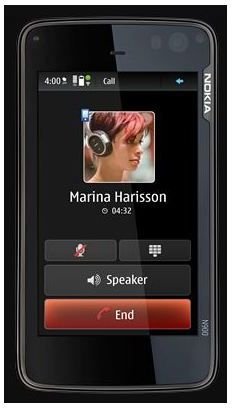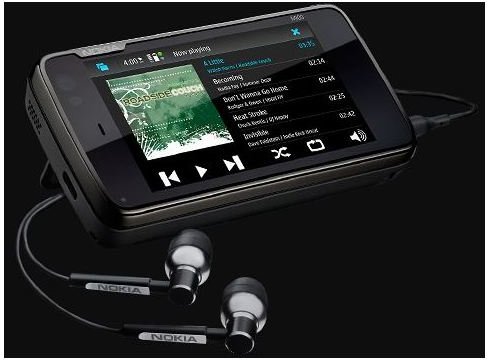Review of Nokia N900 - Part 1
Introduction
The Nokia N900 is another tablet-phone combination from Nokia, following the N800 and the N810. It preceded the Apple iPad by around 5 months, with considerably less hype. It also has a new operating system, Maemo, which is a complete departure from Symbian which usually graces Nokia’s phones.
The handset makes its entry into the smartphone market, eschewing the now-popular portrait format in favour of the landscape QWERTY keyboard. The design and features are explored in greater detail below.
Design (5 out of 5)
The Nokia N900 is an undeniably well-designed phone, with smooth rounded edges and a glossy black finish. The phone is heavy at 181g, but the feel is solid not plastic. It is a large handset, measuring 110.9 by 59.8 by 18 mm, and the space has been utilized well. The screen is quite big at 3.5 inches and it has a resolution of 800 x 480 pixels.
The front of the handset has been kept clutter-free, with the screen slightly recessed under a protective glass covering. There is a secondary camera in the top right corner, and the proximity sensor on the opposite side. The right side has a volume rocker switch, the power button and a dedicated camera/capture button. Interestingly, Nokia has chosen to retain an Infrared port on the device as well.
The bottom edge has a stylus in the corner, a screen lock, the microphone jack and a speaker. The top edge has a second speaker and the microUSB port. The keyboard is accessed by sliding the screen upward, although it does not extend all the way.
The back panel has the camera lens, a dual LED flash, and a sliding hatch to protect the lens. The hatch activates the camera when open, and turns off the camera when slid back into place. Interesting, there is a ring that swivels out from around the camera to prop the device on a surface. While sliding the kickstand back, a magnet ensures it finds its way snugly into place.
The colour scheme is Spartan black, without embellishment. The effect is severe but suited perfectly to the character of the device.
User Interface (5 out of 5)
The N900 is one of Nokia’s flagship devices and therefore is an ideal candidate to showcase their new operating system, Maemo. Creating a new operating system was a surprising move by Nokia as it had just completed the takeover of Symbian. Maemo is Linux-based and is touted to be the first open-source mobile operating system.
The interface is certainly different from Symbian, rivalling others with a smooth finish and interesting design elements. It has a three-tier software architecture where, to get to the main menu, the user has to traverse through a task manager. It is a strange mechanism, and not particularly appreciated. Also, the operating system seems to operate in landscape mode all the time, barring the telephone application. This quirk explains the significant absence of hardware buttons on the front.
The applications all support kinetic scrolling, including the homescreen and the main menu. The web browser really showcases the responsiveness of the screen to touch commands. An interesting effect is built into the device – while skipping from screen to screen, the page zooms in and out.
Another interesting touch is the integration of the hardware into the operating system. For experienced users, the ability to use Ctrl+C to copy will be a real joy.
Features (4 out of 5)

The screen is an excellent example of resistive touchscreen technology, which can be manipulated using the finger and the stylus. The quality of the images is excellent due to the high resolution. The screen holds up well under bright sunlight, which is a relief, since it has been an issue with Nokia Xpress Music handsets.
The keyboard is also excellent, although it does not slide out fully. This seems to be a ridiculous design flaw, as the lack of space has compressed the keyboard considerably forcing the keys into multi-tasking. The arrangement is certainly not conducive to quick typing, in the event that symbols are required. The keys themselves are highly responsive, although small. Unfortunately the keys are not backlit, which would have been a nice addition to the hardware.
The homescreen is a customizable area which can hold widgets, contacts and even web pages for easy access. The pre-installed widgets are minimal but more can be downloaded easily. The homescreen consists of four menus that are accessed via side-scrolling. The second tier, namely the Task Manager, contains thumbnails of all open applications. Somewhat akin to tabbed browsing, a user can immediately view any application through it.
The contacts menu is standard, with one notable exception. Usually when the contact information is stored, there are only set ways to interact with that person. It is therefore highly appreciated when Nokia includes interaction methods based upon the information that is loaded into the contact card. For example, if a contact has a Skype account, the option to Skype with the contact is presented to the user.
The accelerometer is used as an input mechanism; calls can be silenced by turning the phone face-down. Similar actions can turn off an alarm as well.
Strangely, there is no MMS support. Therefore a user would have to use either SMS or email to correspond. It is unusual for such a simple feature to be left out, and is inexplicable. The image gallery is ordinary, strongly proclaiming the device as a business, not pleasure, phone. The music player and camera are also adequate, without being extraordinary.
Connectivity on the Nokia N900 is what lifts the phone to great heights. It supports practically every technology including, but not limited to, GPRS, EDGE and 3G. It also has an expansion slot, in addition to the 32 GB internal memory.
There is an FM transmitter built into the device, which can project clear signals on a chosen frequency. Understandably this feature is dependent on the local radio scenario, but it is still an interesting feature nonetheless.
Performance (5 out of 5)
Lagging screens would be expected in a device that aims to accomplish so much, but the Nokia N900 does not disappoint. The response times are like quicksilver, and applications load without any trouble at all. Perhaps the Task Manager serves as a reminder not to leave too many applications open all at once.
Call quality is crystal clear and completely bereft of interference. The sound emitted from the earpiece is not too loud, but can be easily remedied using the volume control.
The Verdict (5 out of 5)
The Nokia N900 is a brilliant business phone with all the features imaginable. It has brought a number of new concepts to the table, and has managed to pull them off with panache. The phone is certainly priced at the higher end of the spectrum, but it is definitely worth it.
